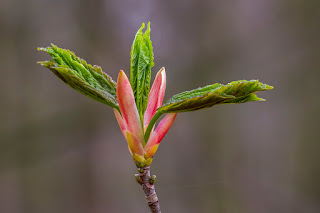Walking in Woods
I walked into the wood. It was dark, and green. Green leaves, green grass, green tinges on
tree trunks; even the air seemed green.
It was also raining; steady, gentle summer rain. I love woods in the wet. There were gentle
sounds of water everywhere: the susurration of the rain itself and the steady
drip, drip of drops off leaves and undergrowth.
Later, the sun came out and drops of water sparkled like jewels, each
holding a perfect, inverted image of the world around it. This was one of the Lincolnshire Limewoods,
relicts of the original primeval wilderness in this part of England. After the last ice age the whole of this
region was forested with small leaved lime and the Limewoods are one of the few
remaining links to wilderness in Lincolnshire.
My
formative years were spent roaming these woods, developing a deep love for
nature that was to last a lifetime. I
knew every tree, birds nest and rare plant, where to find adders and the best
places for newts and frogspawn. I wanted
to explore parts of the wood I didn’t know and so at the toss of a coin chose
the first path and then alternately turned right and then left. I became a forest flaneur for the day. Bird song was a kind of ‘surround sound’; the
hypnotic cooing of doves and pigeons, the harsh shrieking of jays, pneumatic
drilling of woodpeckers, onomatopoeic song of the chiff chaff, the musical
warble of blackcaps and from above the trees the wild mewing of a buzzard
soaring overhead. Flowers spangled the
wood with colour: orchids, ragged robin, dog daisy, wild rose, honey suckle and
many more. The sense of smell was not
neglected, with damp earthy scents of leaf mould and the occasional, floral
notes of honeysuckle.
Walking allows me to slow down and fully experience and
appreciate the landscape that I travel through; to be a ‘human being’, rather
than a ‘human doing’. It not only provides exercise and improves health;
it nourishes the mind, providing spiritual refreshment through contact with
nature. I find it a meditative
experience and often, when walking in mountains, I have the feeling that I
never want to come down. Walking in
woodland, particularly as a flaneur, as on this day, it is easy to lose and
find oneself again, to reflect, meditate and absorb the natural world around
me. One day during a recent trip to
France I was wandering in the Combeau Valley, high in the Vercors mountains,
hunting for orchids and observing nature’s intimate details. Towards the end of the day I lay down to rest,
surrounded by wonderful flowers and views, to meditate and reflect on the
day. I lost myself in the changing
patterns of the clouds above; my body became part of the land beneath me and my
mind wandered among the clouds above. These
moments are transcendental, spiritual times during which I find it easy to
believe in a creator god. Despite being from a science background with a
firm belief in evolution I can reconcile these two concepts in my mind:
evolution being brought about by a creator.
Walking slowly enables me to marvel at the beauty of the
world around me. In particular, I enjoy
the intricate, close-up detail of nature: the beauty of a lichen covered rock,
or a moss encrusted tree, a weathered, silvered tree stump in a forest, the
floor of a wood, detail of a fern or the beauty of a feather. I love the interplay of the weather on the
landscape: clouds, wind, rain, snow and even mist and fog. I revel in the touch and feel of the detail
of the land: the roughness of tree bark, the soft sponginess of moss, the
crispness of dried lichen on a sun-warmed rock or the refreshing coolness of a
mountain stream. When walking I enjoy
seeking out and photographing the intricate detail of nature, the ordinary, the
detail unnoticed by most people, things that most would walk straight past; I
like to uncover the hidden aspects of a place, to ‘make visible the
invisible’.
The natural world is important to me and during my walks
I delight in my observations. I
particularly enjoy woodland and this summer have walked in woods in
Lincolnshire, The Lake District, Scotland and the Cevennes and Vercors
mountains of France. Photographing
nature’s intimate landscapes means that the images could be anywhere; there is
no need, as is the tendency in modern landscape photography, to plant my tripod
legs in the marks of those who have gone before. Gone is the need to photograph in
‘picturesque’ weather, in fact I prefer overcast and even rainy
conditions. Gone, also is need for
‘picturesque and ‘sublime’ locations. The
intimate, close-up detail of nature can be found everywhere: in rural settings,
our edgeland wildernesses, beach and saltmarsh, mountains and even industrial
settings and gardens. In industrial
settings, particularly, nature is adept at reclaiming her own.
I share my feelings about nature through photography and
in the current uncertain times for our planet I entertain positive feelings for
its future and hope that I am not photographing its final days.































I like the 12th image of the tree bark and the way is flows like water
ReplyDeleteI see you in this, my friend.
ReplyDeleteAnd concur with Hazel too.
Frond droplets do it for me (10th image).